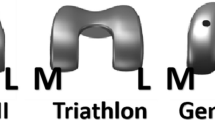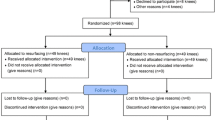Abstract
Purpose
The objective of this study was to determine the effect of patellar morphology and implant design on patellofemoral contact stress in total knee arthroplasty (TKA) without patellar resurfacing.
Methods
Radiographic investigation: One hundred and fifty-seven knees of 127 patients were included in the study. Implants used in the present series were Low Contact Stress (LCS), Genesis II and NexGen. The relationship between the pre-operative patellar facet angle and newly identified post-operative osteosclerosis was assessed. Finite element analysis: Using patient-specific patellar three-dimensional finite element models, the relationship between the patellar facet angle and mean von Mises stress within the patella was calculated at flexion angles of 15°, 45°, 75° and 105°.
Results
Radiographic investigation: Post-operative osteosclerosis was observed with decreasing patellar facet angle in the Genesis II (odds ratio = 0.72; 95% confidence interval, 0.55–0.93; P = 0.012) and NexGen implants (odds ratio = 0.87; 95% confidence interval, 0.77–0.99; P = 0.029). Patients treated with the Genesis II had significantly more advanced osteosclerosis than those treated with the other two implants. Finite element analysis: A negative correlation was found between the patellar facet angle and the mean von Mises stress for all three implants. The Genesis II showed significantly higher von Mises stress than the other two implants at flexion angles of 15°, 45° and 105°.
Conclusions
Both patellar morphology and femoral component geometry influence patellofemoral contact stress in total knee arthroplasty without patellar resurfacing.
Level of evidence
Case control study, Level III.






Similar content being viewed by others
References
Becher C, Heyse TJ, Kron N, Ostermeier S, Hurschler C, Schofer MD, Fuchs-Winkelmann S, Tibesku CO (2009) Posterior stabilized TKA reduce patellofemoral contact pressure compared with cruciate retaining TKA in vitro. Knee Surg Sports Traumatol Arthrosc 17:1159–1165
Bessho M, Ohnishi I, Matsumoto T, Ohashi S, Matsuyama J, Tobita K, Kaneko M, Nakamura K (2009) Prediction of proximal femur strength using a CT-based nonlinear finite element method: differences in predicted fracture load and site with changing load and boundary conditions. Bone 45:226–231
Browne C, Hermida JC, Bergula A, Colwell CW Jr, D’Lima DD (2005) Patellofemoral forces after total knee arthroplasty: effect of extensor moment arm. Knee 12:81–88
Burnett RS, Boone JL, Rosenzweig SD, Steger-May K, Barrack RL (2009) Patellar resurfacing compared with nonresurfacing in total knee arthroplasty. A concise follow-up of a randomized trial. J Bone Joint Surg Am 91:2562–2567
Completo A, Rego A, Fonseca F, Ramos A, Relvas C, Simoes JA (2010) Biomechanical evaluation of proximal tibia behaviour with the use of femoral stems in revision TKA: an in vitro and finite element analysis. Clin Biomech (Bristol, Avon) 25:159–165
Heesterbeek PJ, Beumers MP, Jacobs WC, Havinga ME, Wymenga AB (2007) A comparison of reproducibility of measurement techniques for patella position on axial radiographs after total knee arthroplasty. Knee 14:411–416
Heyse TJ, Becher C, Kron N, Ostermeier S, Hurschler C, Schofer MD, Tibesku CO, Fuchs-Winkelmann S (2010) Patellofemoral pressure after TKA in vitro: highly conforming vs. posterior stabilized inlays. Arch Orthop Trauma Surg 130:191–196
Hwang BH, Yang IH, Han CD (2011) Comparison of patellar retention versus resurfacing in LCS mobile-bearing total knee arthroplasty. Knee Surg Sports Traumatol Arthrosc. doi:10.1007/s00167-011-1593-y
Imai K, Ohnishi I, Yamamoto S, Nakamura K (2008) In vivo assessment of lumbar vertebral strength in elderly women using computed tomography-based nonlinear finite element model. Spine (Phila Pa 1976) 33:27–32
Insall J, Salvati E (1971) Patella position in the normal knee joint. Radiology 101:101–104
Kanamiya T, Naito M, Hara M, Yoshimura I (2002) The influences of biomechanical factors on cartilage regeneration after high tibial osteotomy for knees with medial compartment osteoarthritis: clinical and arthroscopic observations. Arthroscopy 18:725–729
Kessler O, Patil S, Colwell CW Jr, D’Lima DD (2008) The effect of femoral component malrotation on patellar biomechanics. J Biomech 41:3332–3339
Keyak JH, Rossi SA, Jones KA, Skinner HB (1998) Prediction of femoral fracture load using automated finite element modelling. J Biomech 31:125–133
Ma HM, Lu YC, Kwok TG, Ho FY, Huang CY, Huang CH (2007) The effect of the design of the femoral component on the conformity of the patellofemoral joint in total knee replacement. J Bone Joint Surg Br 89:408–412
Merican AM, Ghosh KM, Iranpour F, Deehan DJ, Amis AA (2011) The effect of femoral component rotation on the kinematics of the tibiofemoral and patellofemoral joints after total knee arthroplasty. Knee Surg Sports Traumatol Arthrosc 19:1479–1487
Moglo KE, Shirazi-Adl A (2003) On the coupling between anterior and posterior cruciate ligaments, and knee joint response under anterior femoral drawer in flexion: a finite element study. Clin Biomech (Bristol, Avon) 18:751–759
Munoz-Mahamud E, Popescu D, Nunez E, Lozano LM, Nunez M, Sastre S, Torner P, Segur JM, Macule F (2011) Secondary patellar resurfacing in the treatment of patellofemoral pain after total knee arthroplasty. Knee Surg Sports Traumatol Arthrosc 19:1467–1472
Noble J, Alexander K (1985) Studies of tibial subchondral bone density and its significance. J Bone Joint Surg Am 67:295–302
Pakos EE, Ntzani EE, Trikalinos TA (2005) Patellar resurfacing in total knee arthroplasty. A meta-analysis. J Bone Joint Surg Am 87:1438–1445
Patel K, Raut V (2011) Patella in total knee arthroplasty: to resurface or not to–a cohort study of staged bilateral total knee arthroplasty. Int Orthop 35:349–353
Pavlou G, Meyer C, Leonidou A, As-Sultany M, West R, Tsiridis E (2011) Patellar resurfacing in total knee arthroplasty: does design matter?: a meta-analysis of 7075 cases. J Bone Joint Surg Am 93:1301–1309
Rodriguez-Merchan EC, Gomez-Cardero P (2010) The outerbridge classification predicts the need for patellar resurfacing in TKA. Clin Orthop Relat Res 468:1254–1257
Sawaguchi N, Majima T, Ishigaki T, Mori N, Terashima T, Minami A (2010) Mobile-bearing total knee arthroplasty improves patellar tracking and patellofemoral contact stress: in vivo measurements in the same patients. J Arthroplasty 25:920–925
Shih HN, Shih LY, Wong YC, Hsu RW (2004) Long-term changes of the nonresurfaced patella after total knee arthroplasty. J Bone Joint Surg Am 86-A:935–939
Singerman R, Gabriel SM, Maheshwer CB, Kennedy JW (1999) Patellar contact forces with and without patellar resurfacing in total knee arthroplasty. J Arthroplasty 14:603–609
Verlinden C, Uvin P, Labey L, Luyckx JP, Bellemans J, Vandenneucker H (2010) The influence of malrotation of the femoral component in total knee replacement on the mechanics of patellofemoral contact during gait: an in vitro biomechanical study. J Bone Joint Surg Br 92:737–742
Whiteside LA, Nakamura T (2003) Effect of femoral component design on unresurfaced patellas in knee arthroplasty. Clin Orthop Relat Res 410:189–198
Wiberg G (1941) Roentgenographs and Anatomic Studies on the Femoropatellar Joint: with special reference to Chondromalacia Patellae Acta Orthop Scand 12:319–410
Acknowledgments
Three-dimensional geometric data of each femoral component were provided by DePuy, Smith & Nephew and Zimmer under the non-disclosure agreement. We thank Dr Toru Tsuboya for his support in statistical analysis.
Author information
Authors and Affiliations
Corresponding author
Rights and permissions
About this article
Cite this article
Takahashi, A., Sano, H., Ohnuma, M. et al. Patellar morphology and femoral component geometry influence patellofemoral contact stress in total knee arthroplasty without patellar resurfacing. Knee Surg Sports Traumatol Arthrosc 20, 1787–1795 (2012). https://doi.org/10.1007/s00167-011-1768-6
Received:
Accepted:
Published:
Issue Date:
DOI: https://doi.org/10.1007/s00167-011-1768-6




